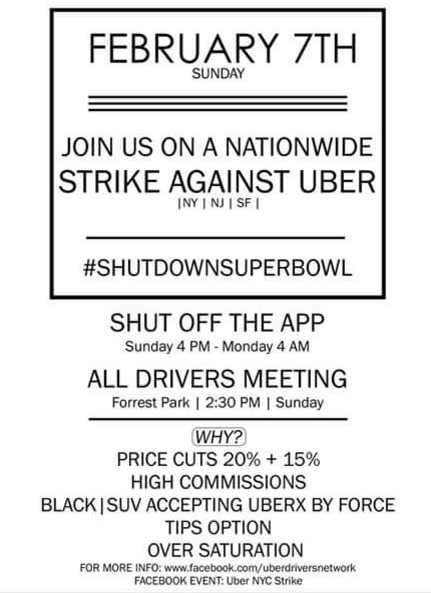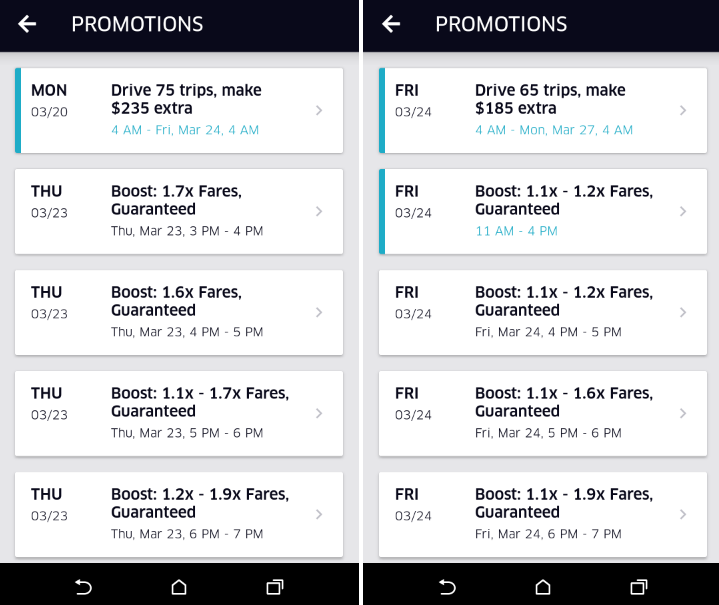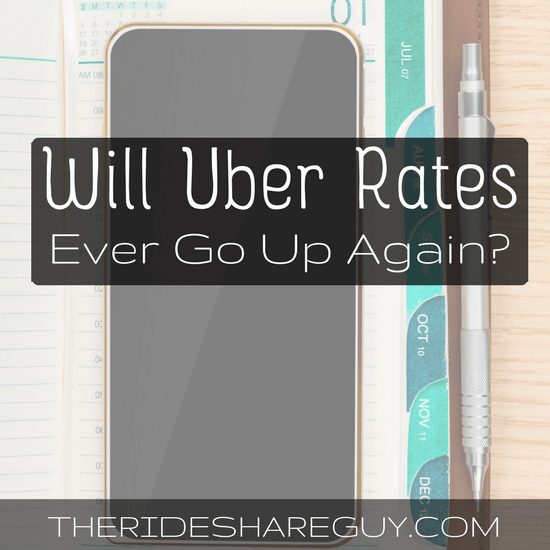Harry here. One of the biggest complaints we hear from drivers is around topics of pay – every driver wants to earn more and see higher rates but will it ever happen? Today, senior RSG contributor Christian Perea takes a look at the few situations that could force Uber to raise rates and examines how likely they are.
After three years of fare cuts, it’s easy to wonder if Uber will ever increase its rates again. I single out Uber here because it is the largest ride-hail company and has the most market share. So Uber plays the biggest part in setting prices for the industry.
Over the last few years, Uber has led the vast majority of steep price cuts for drivers. Whenever Uber lowers prices, Lyft follows within a few weeks. Even smaller rideshare companies like Via, Fasten, or Fare are forced to set prices in line with what Uber pays. This means Uber is the dominant player in the ride-hail market and effectively sets prices.
This is known as oligopolistic competition. (What is that? See Khan Academy)
How Can Pay Increase for Drivers?
I’ve outlined a few scenarios below and rated their likelihood of happening. I wouldn’t expect price hikes tomorrow, or to rely on this article as a reason to continue driving in the long-term. However, I think these are real factors that affect what Uber is able to charge passengers (and thus pay drivers) moving forward.
Uber IPO’s
Likelihood: Low (In 2017)
If Uber is to IPO, it is going to have to report sound financials and make them available to the public. This could lead to cutting driver promotions and replacing them with higher rates. Theoretically this could allow Uber to become profitable almost immediately.
However, I don’t think Uber will IPO this year. Its financials are a mess, the brand is tarnished in scandal, and I honestly can’t imagine Uber operating under public scrutiny until management makes some major changes or Travis hires Tony Robbins as a life coach.
But even if it does IPO this year, I think Uber would be more likely to increase its effective “cut” from passenger fares while slightly raising prices (oh wait they’re already doing that). And Uber could do this while also lowering or eliminating driver “promotions”. The result is that Uber could build a wider “spread” that would allow it to show a profit on rides without disrupting things too much.
Lyft Dies And Uber Becomes a Monopoly!
Likelihood: Low
Some drivers have said that if Uber managed to kill off Lyft, then Uber would go back to charging higher prices to passengers. In this theory, Uber would be free as a monopoly to charge whatever it wanted to passengers without any significant competitor undercutting it.
The problem with this theory is that it assumes Uber would go out of its way to share those increased prices with drivers. If Uber became a monopoly, then it would also be the only option for drivers. So there would be no incentive to do so, especially if drivers continue to give rides at low pay.
Drivers Successfully Strike
Likelihood: Low
In 2014 I tried to organize a strike/protest against Lyft in San Diego after they dropped driver pay (on my birthday). I actually got around 50-60 drivers to participate for 3 weeks each Saturday night for an hour. I organized the whole thing using a half-broken HTC M9 since my computer was in a pawn shop because I needed gas money earlier in the week (this was long before Express Pay).

On-demand strikes are very difficult because they require a significant portion of drivers to cooperate. Further, incentives are high to break the strike (surge, and last-minute promotions). On top of that, most drivers don’t even talk to other drivers. So cities that have a lot of part-time drivers are less likely to see any success since most weekend drivers are just average people trying to make an extra $100 bucks (Harry…).
I got most of the “hardcore” Lyft drivers to participate. That wasn’t nearly enough drivers. The next step (proposed by Zebra Lyft) would have been to request drivers to our “protest” zone in order to tie up the dispatch system and then gain driver participation when they arrived by bribing them with pizza, all while having the press around. The problem with this though is that it would guarantee that we all (and especially me) got deactivated.
NYC and Seattle: Where Strikes/Labor Action Can Work
Strikes only have a chance of working when drivers have shared interests. NYC drivers require way more investment and licensing in order to get on the road. This means that almost every NYC driver is a full-time long-term driver, and that gives them similar goals to cooperate with each other during protests or strikes. This is why Uber has tried to lend an ear to NYC drivers by donating to The Independent Driver Guild and at least sometimes pretending to listen to driver demands in NYC.
Seattle enacted an ordinance to allow Uber drivers to unionize. Uber is so opposed to this that they have actually hired anti-union firms and began to beam a podcast into the driver’s app in Seattle to convince drivers that unions will take away their “flexibility” and other stuff.
Strikes and labor actions might affect driver pay in limited environments like NYC, but those efforts will likely remain confined to local areas if they even have an effect at all.
People Naturally Stop Driving Due To Low Pay
Likelihood: Medium – High
I think Uber’s labor pool is going to be pretty large in the short-term. But driving for Uber isn’t as “cool” as it used to be. Three years ago when I told people I was an Uber driver, people would say, “I hear they make good money!” Now they are more likely to say, “Hey man, do you need any help with your resume? Are you doing all right?”
Our 2017 survey showed that Uber drivers reported earning around $15/hr in gross pay. However, that is before expenses. I reckon that makes whatever is left over pretty close to minimum wage in a lot of places. As one who worked several minimum wage jobs in high school, I can tell you they were all far less risky than driving for Uber. So if being an Uber driver ends up competing with minimum wage jobs in the long-term on pay, then Uber may be forced to raise prices to make driving more appealing. To Uber’s credit though, it is more flexible than jobs of comparable wages.
I actually saw some limited evidence of this in 2016 right after the “Winter Warm-up” price cuts by Uber. I had never seen so many drivers flock to Lyft. Lyft was chock-full of driver supply for a solid month while Uber was left with a big driver supply problem. The situation was becoming dire for Uber, because it led to high surge and high ETA’s, meaning passengers began to switch to Lyft too. It was this that actually led to them rapidly deploying their own Power Driver Plus and Boost Zones.
The Driving Factor: Uber Will Need To Eventually Show A Profit
Reality has a way of intruding.
Right now, Uber is still providing an insane amount of promotions and subsidies to get passengers to request rides and pay drivers to provide those rides for little pay. According to Eric Newcomer at Bloomberg, Uber lost more than $2.2 billion dollars in 2016 alone. I suspect a lot of those losses were centered around things like Boost Pay, Driver Quests, and $500 “become an Uber driver” bonuses. In some places, many drivers are earning over $600 per week in these promotions ON TOP of their fares from Uber.
Below are my promotion/subsidies for the week of 3/24/17. Notice that there are 2 quests for the week: one for $235 and one for $185 ($420 total). Plus a bunch of guaranteed Boost to my fares!

All of those “promotions” add up fast…
The San Francisco Treasurer’s Office claimed last November that there are 45,000 rideshare drivers in San Francisco. Let’s assume for a moment that only half of that 45,000 still drive (since we know half of all Uber drivers quit after one year). Our 2017 survey showed that 49% of rideshare drivers in San Francisco are full-time! So that would be around 11,025 Uber drivers taking advantage of these subsidies each week. Let’s assume that these drivers get both quest bonuses and a couple hundred dollars in boost. We’d get:
11,025 Uber Drivers X $600/wk = $6.615 million/week = $343+ million/year in Uber driver subsidies. Just for San Francisco!
As much as I like all of these promotions from Uber, it is important to remember that they serve the purpose of artificially increasing the supply of drivers on the road. Without that, Uber would have an intense challenge maintaining short eta’s, lower prices, reliability and retention or its driver supply.
Will Uber Deploy Autonomous Cars Before They Run Out of Cash?
I think Uber is betting that it will be able to deploy a fleet of self-driving cars before it runs out of its significant cash reserves. Make no mistake, Uber still have a ton of weaponized cash. In the meantime, this means Uber finds more value in building out a deep network of passengers. That way when the robots come, Uber has the customer advantage and can just plug them into its existing network of passengers who regularly use the app.
However, if the robots cannot show up on time for Uber (or if they get locked in a court-room), then Uber might find itself in a tight spot where they are forced to reckon with the reality of paying an army of people to drive people around. Presently, that would require having prices at a higher point for passengers to create a sustainable supply of drivers.
Drivers, do you think we will ever see higher prices and pay or do you think robots will replace us first? Let me know below!
-Christian @ RSG





